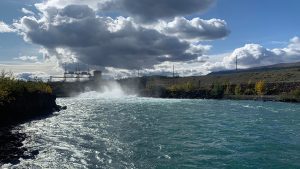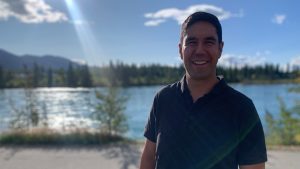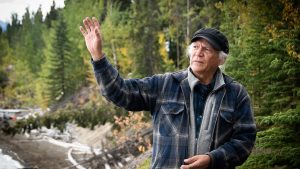It was only a few decades ago that Marsh Lake in Yukon’s Southern Lakes region was rich in Chinook salmon.
During the late summer months, thousands of Chinook would migrate through Marsh Lake upstream to their spawning grounds in the Southern Lakes.
Ḵaa Shaadé Hení (Chief) Maria Benoit of the Carcross/Tagish First Nation (C/TFN) can still remember tales from the Elders of how plentiful Chinook runs were.
“There used to be so much salmon here a long time ago that people could cross the creek on their backs,” she recalls. “There were that many of them.”
Chinook are the largest of the Pacific salmon species. Spending most of their lifetime in the cold, upper reaches of the Pacific Ocean, mature salmon migrate thousands of kilometres to the Pacific northwest in late summer to spawn.
It’s a time that continues to hold special significance for First Nation’s people in the territory.
Long before the first stampeders came to Yukon hungry for gold, First Nation’s fish camps dotted the banks of the Yukon River and its tributaries each summer.
Fish camps ensured not only survival but also brought together people and families in harmony with the natural environment around them.
Benoit said in decades past, the Tagish Kwan people camped along Marsh Lake and would harvest from places like the McClintock River in order to take what they needed.
“The salmon was always part of our lives because we lived and survived off of salmon,” she said.
Then the dam came.
According to Kwanlin Dün First Nation’s book Dä́kwändür Ghay Ghàkwädīndür – Our Story in Our Words, the dam, which was completed in 1958, drastically altered Chinook runs.
It states that up until that point, the McClintock fishery often yielded 300 salmon a day during peak runs in mid-August.
But in the first year after the dam was completed there was no accompanying fish ladder, preventing two upriver salmon runs from migrating.
The book details how fry journeying back to the ocean couldn’t navigate their way over the blockage created by the dam. Many young fish became weakened and wounded in the process, making them easy targets for predators like eagles.

Elder Charlie Burns is quoted as saying “(W)e didn’t want (the dam), but they built it. Because we got no authority to say anything.”
While First Nations people carried salmon in gunnysacks above the dam, and a 366-metre fish ladder was built in 1959 to help salmon with their passage, the book states “the run was never the same again.”
“Tens of thousands of fish died, despite efforts by our people… The runs have still not returned to their pre-dam levels.”
Benoit said, unlike her ancestors before her, her generation has never been able to harvest in the Southern Lakes area because of the dam.
“We never, ever came here fishing for salmon,” she said.
‘Every salmon matters’
According to data from Fisheries and Oceans Canada (DFO), as of Aug. 27, 15,304 Chinook have been counted at the Eagle sonar at the border of Alaska and Yukon.
While it’s a small increase from the 12,000 that were counted last year, it’s still well below the 10-year historical average of around 50,000 fish.
In Whitehorse, just over 150 salmon have been counted this season at the fish ladder, which is a few fish less than the 165 that made it through last year. Those numbers fall short of the 10-year historical average of 860 fish.
Jaclyn Kendall, a DFO fishery manager for the Yukon River, said in an email to APTN News a number of Pacific salmon populations are in decline across much of their historical range.
“There is likely not one root cause to the decline, but cumulative impacts from a range of factors,” she said.
She noted changes in ocean conditions such as increased sea surface temperatures have changed food web dynamics and overall salmon health and survival.
Other factors, like habitat degradation, predation and extreme environmental events “are all contributors to the reduction in the number of salmon making it back to the Yukon River to spawn,” she said.
James MacDonald, a Ta’an Kwäch’än Council (TKC) citizen who sits on the Yukon Salmon Sub-Committee, said Chinook “continues to be in a bit of a crisis.”
“The numbers are way, way down from historical numbers…We’re in a desperate situation to save our salmon,” he said.
A DFO bulletin states as of 2021 and 2022, Canada’s recommended management objective for Canadian-origin Chinook is 55,000 fish.
That objective ensures there are enough salmon to reach spawning grounds each year to sustain their population and provide for current and future harvest opportunities.
“Similar to previous years, 2019 to 2022, the return of Canadian-origin Chinook salmon will not be large enough to achieve the spawning escapement objectives, nor provide for harvest opportunities in either Alaska or Canada,” it goes on to say.
MacDonald says it is imperative First Nations harvesters, anglers and commercial and domestic fisheries alike refrain from fishing.
“The numbers are so low that every salmon matters, so every salmon that is able to spawn, we’re trying to encourage people to allow them to spawn so that they can reproduce and come back for future generations,” he said.

MacDonald said ultimately, the loss of Chinook is an issue everyone should be concerned about it.
“Everyone should care about salmon because if it happens here it can happen elsewhere and it affects everybody. We’re a fish Nation and we should all care about fish.”
Current situation ‘not good at all’
For Benoit, this season’s run is yet another year of disappointing numbers.
“That’s really, really sad. That’s not good at all,” she said while reflecting on the situation.
As a way to combat the loss of salmon, Benoit said her First Nation now gets its salmon from the nearby neighboring community of Atlin in northern B.C.
She said there’s a real fear for future generations, who may never get to experience the joy of harvesting at fish camp. She noted it’s important for older generations to pass down their knowledge in order to teach young people and youth.
“It’s going to be tough for their future. I’m afraid for them,” she said.
Salmon ‘resilient’
Despite the uncertainty surrounding the salmon, Carcross/Tagish citizen Mark Wedge said like First Nation’s people, Chinook are resilient.
The knowledge keeper and former chief said preparations need to be made to help the salmon return home. He describes Indigenous prophecies that foretold of difficult times for his people – but also prophecies that spoke of how things would get better.
He said one prophecy tells of how a nine-legged animal that would do good.
“Look at our caribou recovery plan… it took nine governments working together to make that happen,” he said.
He’s confident Yukon’s salmon situation will improve and that First Nations people in the territory can find the solutions they need in their Indigenous teachings, ceremony and caring for the land and water.
“Is it redesigning fish ladders, is it using traditional knowledge, a combination of using spirituality and ceremony, as well as science and technology to start figuring out how to bring those salmon home now?” he said.
“What we’re trying to do is bring those Indigenous concepts into how we build into our relationship with the land and the water… How do we build those into the systems that we have to look after this land together with?”

Last month, C/TFN, TKC and Kwanlin Dün released Connecting the Broken Salmon Trail: Our Relationship with Southern Lakes Salmon.
The document is described not as a technical or harvest plan, but as a joint plan aimed at restoring and prioritizing the vital role salmon play in the three First Nation’s culture, languages, landscapes and laws.
Wedge also points to How We Walk with the Land and Water, another joint Indigenous Land Relationship Plan by the three First Nations.
Its goal is to prepare for Chapter 11 land use planning by creating a unified First Nation vision for the Southern Lakes region rooted in Indigenous story, law, knowledge and affirmed by Western science.
As the water-use license for the Whitehorse dams will expire in 2025, Wedge noted C/TFN is in negotiations with Yukon Energy and Yukon government to ensure its rights and interests are heard and protected.
The negotiation will also focus on the historical and ongoing environmental and cultural impacts of the dam.
Wedge said while there are few salmon in the Southern Lakes region for now, he’s hopeful they will come back – as long as everyone works together in a good way,
“When we start working together, that’s when you become strong, and that’s when the animals say ‘OK, you’re doing your part, now we’ll do our part.’”









